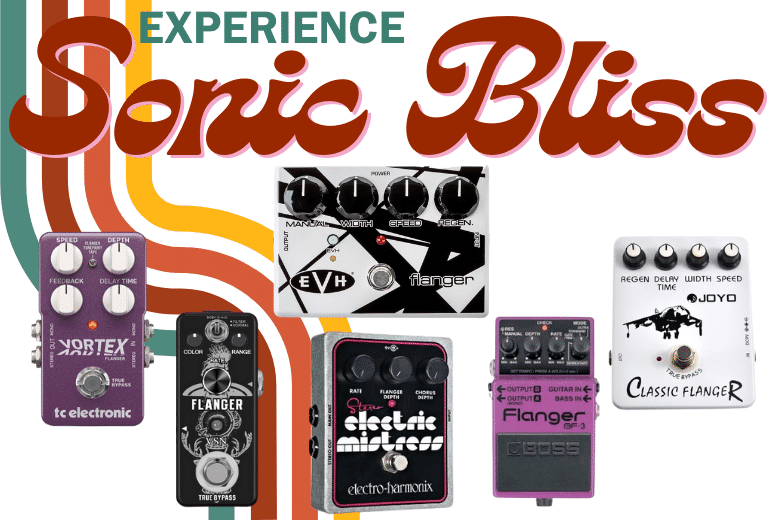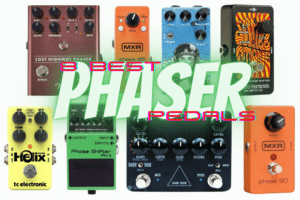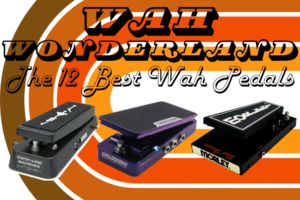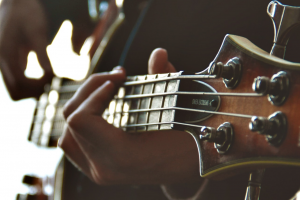Introduction to the Best Flanger Pedals
Flanger pedals are a popular type of guitar effects pedal that produce a swirling, jet-like sound that can add depth and dimension to your guitar tone.
Interestingly, the flanger pedal was created by of experimenting with unique sounds on reel-to-reel tapes or tape machines. As musicians heard the sounds, the effects became integrated into music via the flanger pedal.
When it comes to the best flanger pedals on the market, there are several top contenders to consider. One of the most highly-regarded flanger pedals is the Electro-Harmonix Electric Mistress, which features a rich and dynamic sound that can be customized to your liking using its various controls.
Another great option is the MXR EVH117 (Eddie Van Halen) Flanger, which offers a range of classic and modern flanger sounds and has a durable and reliable construction.
For those on a budget, the Joyo JF-07 Classic Flanger is a fantastic choice that delivers impressive effects at an affordable price point.
Quick View: My Favourite Flanger Pedals

1-Boss BF-3 Flanger Guitar Effects Pedal
The Boss BF-3 Flanger offers lush, versatile flanging effects, smooth controls, and rock-solid reliability for an immersive and captivating guitar experience.


2- Electro-Harmonix Stereo Electric Mistress
Combines rich analog chorus and flanger effects in one pedal, delivering lush, dynamic modulation with stereo capabilities.


Offers vintage flanging tones, simple yet effective controls, and budget-friendly affordability for a great addition to your pedalboard.


4- TC Electronic Vortex Flanger Pedal
TC Vortex Flanger Pedal boasts versatile flanging effects, TonePrint technology for endless customization, and top-notch build quality in a stompbox.


5- VSN Guitar Flanger Pedal for Analog Flanger
The VSN Guitar Flanger Pedal delivers authentic analog flanger effects with true bypass, durable construction, and easy-to-use controls, all at an affordable price.


The MXR EVH117 Flanger Pedal offers iconic Eddie Van Halen tones, script switch for vintage authenticity, and rugged MXR build quality.”

What is a Flanger Pedal?
A flanger pedal is an effects pedal commonly used with electric guitars and other electronic instruments to create a unique sound effect. It works by splitting an incoming audio signal into two identical signals, delaying one of them by a small amount, and then blending them back together.
The resulting sound is characterized by a sweeping, swirling effect that creates a sense of movement and depth. The amount and speed of the delay can be adjusted using controls on the pedal, allowing for a wide range of different flanging effects.
Flangers are often used in rock, metal, and experimental music to add texture and complexity to a guitar or synth sound.
Overview of Flanger Pedal Content
To better understand the importance and popularity of the flanger pedal, I will discuss many aspects such, as a beginner’s guide to flanging pedals, how to choose a flanger pedal, a brief history of the pedal, how it works, how it produces the effects on the guitar, as well as showcasing the top six flanger pedals.
My name is Lee. I’ve been playing guitar for over 25 years, and I’ll give you all you need to know about Flanger Pedals in this detailed guide.
Flanger Pedals 101
A flanger pedal is an effects pedal used in guitar and other musical instruments to create a distinctive swirling sound.
Most popular with guitar players, the flanger has been used by many bands such as Metallica, Heart, Black Sabbath, and The Police.
The pedal typically comes with controls like manual, resonance, depth, and rate to adjust and fine-tune the intensity and character of the effect. The resulting sound is often likened to a jet plane’s whoosh.
To achieve and manipulate this effect, flangers come equipped with several controls.
Although there are four main controls that you should know about if you are just learning and starting to play the guitar, you may also read about other pedal features that are important.
What Are the 10 Features of a Flanger Pedal?
The four main pedal features are:
Rate: The rate control adjusts the speed of the sweeping effect, i.e., how fast the delay time changes. Typically, this is measured in milliseconds, and the higher the value, the faster the sweeping effect.
Depth: The flanger depth control adjusts the intensity of the sweeping effect, i.e., how pronounced the effect is. The higher the value, the more pronounced the sweeping effect.
Resonance: The resonance control adjusts the resonance or feedback of the sweeping effect. Higher values result in a more pronounced and prolonged sweeping effect, while lower values result in a more subtle effect.
Manual: The manual control adjusts the center frequency of the sweeping effect, allowing you to focus the sweeping effect on a specific frequency range. This feature is useful for creating specific tonal colors or for emphasizing certain parts of a riff or solo.
Overall, the combination of these pedal features allows musicians to create a wide range of tonal colors and dynamic effects that can add depth and dimension to their playing.
The other six pedal features are:
Width or Range: This control can adjust the range over which the delay time varies, determining how far the sweep of the flanger goes.
Mix or Blend or Level: Some flanging pedals have this control to balance between the dry (unaffected) signal and the wet (affected) signal. This allows you to blend the flanger effects with your original sound to your liking.
Mode or Type Switch: Some advanced flange pedals may offer different types of flanging. This toggle switch lets you select between those different flanging effect styles.
Bypass Switch: Like most pedals, the flanger pedal will usually have a footswitch that allows you to turn the flanging effect on or off.
LED Indicator: This light indicates when the flanger effect is active.
Input/Output Jacks: For connecting the guitar (input) and sending the signal to an amplifier or other devices (output).
You’ll find that on some models, like an analog pedal, there may be a voice switch, which can be useful. The Voice Switch lets you choose between two flanging effect tones. When set to the down position, the flanger produces a classic, full-frequency sound. Switching it to the up position delivers a sound with reduced bass tones.
One last thing to note about these pedal features is that the specific controls and characteristics can vary slightly from one flanger pedal to another. Different manufacturers and models will have variations, so it might be a good idea to check the manual for nuances.
Understanding a Guitar Effects Pedal
Guitar effects are devices that modify the sound of an electric or acoustic-electric guitar. These effects can be used to create various tonal qualities and manipulate the sound of the guitar in different ways.
There are many types of guitar effects pedal, including distortion, overdrive, delay, reverb, chorus, flanger, phaser, wah, and more. Each effect has its own unique sound and purpose.
Guitar effects work by processing the signal from the guitar and altering certain aspects of it.
For example, distortion and overdrive effects add gain to the signal, which increases the amplitude and creates a distorted or overdriven sound.
Delay and reverb effects create echoes and reflections of the original signal, which add depth and spaciousness to the sound.
These effects can be achieved through the use of analog circuits, digital processing, or a combination of both. Some effects are built into guitar amplifiers or pedals, while others are standalone units that can be connected to the guitar and amplifier using cables.
Overall, guitar effects offer a wide range of creative possibilities for guitar players and are essential tools for crafting unique sounds and styles.
Full Review: Top 6 Flanger Pedals
1-Boss BF-3 Flanger Guitar Effects Pedal
Most Versatile Flanger Pedal

The Boss BF-3 Flanger Guitar Effects Pedal stands out as the most versatile option on the market due to its comprehensive range of modulation effects and intuitive controls, catering to guitarists seeking diverse sonic possibilities.
With various modes, including Ultra and Gate/Pan, it covers a broad spectrum of flanger tones from classic to experimental, accommodating players across genres. The pedal’s manual, momentary, and tap-tempo modes allow for real-time adjustments, providing adaptability during performances.
Guitarists who frequently shift between traditional and contemporary sounds will find the BF-3 particularly beneficial. Its versatility is apt for experimental musicians looking to push sonic boundaries while also appealing to those seeking iconic flanger tones akin to renowned artists.
With adjustable parameters like flanger depth and resonance, it caters to both subtle, textured enhancements and bold, pronounced sweeps. The stereo output suits studio artists and live performers seeking immersive spatial effects.
Therefore, the Boss BF-3 Flanger is the go-to choice for guitarists craving a versatile modulation pedal that effortlessly accommodates a wide array of musical styles and preferences.
Pros
Diverse range of flanging tones.
Tap-tempo functionality for precise modulation rate control.
Stereo output enhances spatial effects.
Cons
Slight learning curve due to multiple controls and modes.
2- Electro-Harmonix Stereo Electric Mistress Chorus Analog Flanger Pedal
Editor’s Choice for Classic Hendrix Tones

The Electro-Harmonix Stereo Electric Mistress Chorus/Flanger Pedal is renowned for epitomizing the classic sound that guitarists seek. Its analog based circuitry delivers a rich and warm tone reminiscent of iconic vintage pedals, making it the epitome of classic modulation effects.
Commonly known as the EHX pedal, its chorus depth and flanger modes evoke a sense of nostalgia, appealing to guitarists aiming to replicate the legendary tones of the past.
For those seeking the signature tones of guitar legends like Jimi Hendrix, this pedal holds particular relevance. Hendrix often utilized lush chorus and swirling flanger effects to create his distinctive and authentic psychedelic flanger sound.
The Electric Mistress can faithfully recreate those vintage modulations, providing guitarists with a direct path to achieving Hendrix-like tones.
Guitarists looking to evoke the classic vibes of the ’60s and ’70s will find the smooth Electric Mistress tone highly suitable. Its ability to recreate the lush chorus tones and ethereal flanging effects of that era makes it a top choice for players seeking to infuse their music with a timeless quality.
The controls on the Electro-Harmonix Stereo Electric Mistress Chorus/Flanger Pedal allow for precise sound sculpting, tailoring the modulation to your preference.
Here’s how each control can be optimized, including the Filter Matrix and Delay Time knobs:
Delay Time Knob: Adjusting this knob changes the time between the original signal and the modulated signal, affecting the depth and speed of the chorus or flanger effect.
A shorter delay time results in a faster, more pronounced modulation, suitable for vibrant and noticeable effects. A longer delay time yields a smoother and subtler modulation, ideal for creating gentle waves of sound.
This control is crucial for adapting the pedal’s effect to match different tempos and styles.
Feedback Knob: This control alters the intensity of the modulation effect by adjusting the amount of signal fed back into the effect’s circuit. Higher settings can result in more pronounced and resonant swirls, while lower settings provide a tamer, less intense modulation.
Range Knob: The Range knob governs the depth controls of the modulation sweep, influencing the width of the effect. At lower settings, the modulation is more subtle and focused, while higher settings create broader and more pronounced sweeps.
Filter Matrix Switch: The Filter Matrix mode freezes the filter sweep at a particular point, allowing you to create a static and resonant tonal texture.
This mode is excellent for adding a unique layer to your sound or emphasizing specific frequencies within the digital modulation effects. It’s particularly useful for experimental and ambient soundscapes.
In summary, the Delay Time knob controls the speed of modulation, the Feedback knob adjusts the intensity, and the Range knob dictates the breadth of the effect. The Filter Matrix mode offers a distinct textural layer, ideal for experimental applications.
By mastering these controls, you can fine-tune the Stereo Electric Mistress to match your playing style and achieve the desired classic chorus and flanger sounds.
Pros
Analog Vintage Tones: Delivers warm and classic chorus or classic flanger
Filter Matrix Mode: Offers a unique frozen filter mode sweep effect, allowing for creative sound
Versatile Sound Sculpting: Precise control over delay time, feedback, and range
Cons
Somewhat expensive compared to other options
3- Joyo JF-07 Classic Flanger Guitar Effects Pedal
Best Value Flanger Pedal

The Joyo JF-07 Classic Flanger Guitar Effects Pedal stands out as a top-value option due to its combination of affordability and solid performance. For guitarists seeking an essential flanger without breaking the bank, the JF-07 offers a compelling solution.
Its straightforward interface features knobs for Delay Time, Regen (feedback), and Width, providing ample control to shape flanging effects to individual preferences.
This pedal is especially suitable for budget-conscious players and beginners looking to experiment with flanging effects without a significant investment. Its simplicity ensures ease of use, making it accessible to those new to modulation effects.
The JF-07 excels at producing classic flanger tones reminiscent of the ‘80s, making it a preferred choice for guitarists aiming to capture that era’s iconic soundscapes.
The JF-07’s simplicity, affordability, and ability to deliver the classic effect make it a suitable choice for musicians looking to experiment with a modulation pedal without a significant financial commitment or experience.
Pros
Affordable Modulation: Budget-friendly access to classic effects.
Intuitive Controls: User-friendly Delay Time, Regen, and Width Adjustments.
Vintage Tones: Emulates iconic 1980s flanger sounds.
Cons
Some users report that the modulation pedal can be noisy or produce unwanted feedback
4- TC Electronic Vortex Flanger Pedal
Best Choice for Professionals

The TC Electronic Vortex Flanger Pedal distinguishes itself as the premier choice among professional-grade flangers due to its exceptional sound quality, extensive control, and innovative features.
With a 24-bit processing engine and a true stereo I/O configuration, it maintains pristine audio fidelity while delivering immersive modulation effects.
The pedal’s TonePrint technology further elevates its appeal, enabling users to access a multitude of custom presets or craft their own, tailoring the flanger to their sonic vision.
One standout benefit is the Vortex’s dynamic versatility, offering classic jet-like sweeps to experimental soundscapes. Its controls encompass Speed, Depth, Feedback, and Delay Time, allowing precise modulation sculpting.
The ‘Beam’ feature facilitates transferring custom presets through smartphones, enhancing on-the-fly adaptability. True Bypass switching ensures unaltered tone integrity when the effect is disengaged.
With a broad array of tones, studio-grade technical specs, and the ability to seamlessly integrate into any professional setup, the TC Electronic Vortex Flanger Pedal excels as the ultimate choice for serious guitarists and studio professionals seeking unrivaled flanging capabilities.
Pros
Studio-Grade Fidelity: 24-bit processing engine and true stereo I/O maintain exceptional sound quality.
Versatile Tone Sculpting: Extensive controls and TonePrint technology
Customization: TonePrint technology allows users to access or create presets, tailoring the pedal.
Cons
Complexity for Beginners: The advanced features and controls might be overwhelming for novice users
5- VSN Guitar Flanger Effects Pedal
Excellent Flanger Pedal for Beginners

The VSN Guitar Flanger Pedal for Analog Flanger Effect stands out as the ideal choice for novice flanger users due to its simplicity, affordability, and quality performance.
Designed with beginners in mind, this analog flanger pedal offers an uncomplicated interface featuring Speed, Depth, and Regen knobs, allowing users to easily grasp and adjust flanger effects without overwhelming complexity.
One notable benefit is the pedal’s circuitry, which imparts warm and authentic flanging tones. Its straightforward controls enable users to quickly achieve classic flanger sounds reminiscent of iconic tracks.
With its durable build and true bypass design, the analog flanger pedal ensures signal integrity and longevity. The VSN Guitar Flanger Pedal offers an affordable entry point into the world of modulation effects, providing new guitarists with the opportunity to explore the distinctive sound of flanging without a steep learning curve or financial commitment.
Its intuitive interface, analog tonal qualities, and budget-friendly nature make it an excellent choice for beginners seeking to experiment with flanger effects.
Indeed, it is a very popular analog flanger pedal model with beginner guitarists for a reason.
Pros
Beginner-Friendly: Intuitive interface and simple controls cater to novice users.
Authentic Analog Tones: Delivers warm and classic effects.
Affordable: Budget-friendly option for those new to modulation effects.
Cons
May not be as durable or reliable as some higher-end options
6- MXR EVH117 Flanger Guitar Effects Pedal
Best Overall Flanger Pedal

The MXR EVH117 Flanger Guitar Effects Pedal emerges as the ultimate flanger pedal in the market due to its blend of superior sound quality, versatility, and precision engineering. This pedal is a collaborative effort between MXR and Eddie Van Halen, and it’s designed to mirror his iconic flanging sound.
Its bucket-brigade circuitry maintains authentic analog warmth and clarity, while the manual, speed, width, and regeneration controls enable users to craft a wide spectrum of flanger effects with remarkable accuracy.
A standout feature is the EVH117’s “Script” switch, allowing users to toggle between two distinct flanger voicings—one modeled after early ’70s pedals and the other resembling the late ’70s “jet plane” flange.
This versatility ensures that players can capture an array of classic flanging tones. Furthermore, the pedal incorporates a distinctive footswitch design that matches Van Halen’s preferences for onstage ease of use.
The MXR EVH117 Flanger’s ability to faithfully replicate Eddie Van Halen’s signature flanger sound while also offering customization options and user-friendly design sets it apart.
Its exceptional sound quality, meticulous attention to detail, and nuanced controls make it an unparalleled choice for musicians seeking to incorporate professional-grade flanging effects into their playing.
Pros
Eddie Van Halen Collaboration: Crafted to replicate his iconic flanger sound, offering authentic tones.
Versatility: “Script” switch provides two distinctive flanger voicings for a range of classic tones.
Precision Engineering: Manual, speed, width, and regeneration controls ensure accurate and detailed flanger effects.
Cons
Its nuanced controls might be challenging for novice users to navigate, potentially requiring some learning time to fully exploit its potential.
What Should You Consider When Choosing a Unique Flanger Pedal?

12 Points for Buying a Flanger Effects Pedal
Choosing a flanger pedal for your guitar can be an exciting endeavor! But, before you begin, you should think about what you need and what you expect from your new pedal.
Do you need a compact pedal, a modulation pedal, an analog flanger pedal, or stereo flanging? You might even want something unique and are looking for a completely distinctive flanging sound.
Regardless of your needs, the following twelve point list will help you find a versatile pedal.
- Sound Quality:
The most important factor is how the pedal sounds. Listen to demos online if you can, or even better, try the flanger effects out in person. Different flange pedals have distinct tonal characteristics, and you want the one best for your purposes. - Controls & Features:
Look for pedals that offer a range of controls to shape the flanger effects. Common controls include the rate, the depth, the resonance or feedback, the manual, and the mix or blend. - Analog vs. Digital:
A classic analog flanger uses bucket-brigade devices (BBDs) to create the delay, resulting in a warm and vintage tone. Digital flangers can offer more versatility and precision but might sound more sterile to some ears. - True Bypass Switching vs. Buffered Bypass:
True bypass ensures that when the pedal is off, it doesn’t tarnish your tone in any way. Buffered bypass can be beneficial in long signal chains to prevent high-end frequency loss. - Stereo vs. Mono:
Some flanger effects pedals offer mono and stereo outputs. The stereo flanging can be useful if you’re running a stereo rig or want to use the pedal in a studio context. - Build Quality:
A sturdy construction is essential if you’re going to be doing lots of gigs or using the pedal frequently. Metal chassis tend to be more durable than plastic ones. Basically, you want a reliable and durable flanger pedal. - Size and Style:
Depending on the space available on your pedalboard, you might prefer a smaller “mini” pedal or you might be okay with a larger unit. You’ll want to check this out before committing to a specific flanger pedal. - Power Requirements:
Be sure that the power requirements of the pedal are the same as your power supply or setup. - Price:
Set a budget and try to find the best flanger effects pedal within that range. Remember, the most expensive option isn’t always the best for your specific needs. Be sure to check the flanger effects that you want because they will probably be available on a cheaper model matching your budget. - Versatility:
Some flanger pedals might offer additional effects or modes, like chorus or vibrato. If you’re looking for a multi-functional pedal, consider these options. - Brand Reputation:
Established brands often offer reliable quality and better customer support. They have better warranties, too, and are known for their excellent reputations. - Reviews and Recommendations:
Read reviews, ask for recommendations from fellow musicians, and check out online forums and communities. Personal experiences from other users can be really helpful. Finally, it is important to note that the best flanger effects pedal is the one that fits your personal needs and musical preferences. Trust your ears and choose the one that inspires you the most.
4 Things You Should Know Before Buying The Right Flanger Pedal
When it comes to buying a flanger pedal, there are a few key things to consider:
1. What is the flanger effect?
The flanger effect is a modulation effect that creates a sweeping, engine like sound by taking an audio signal and duplicating it, delaying the duplicated signal slightly, and then mixing the two signals together.
This results in a comb-filter-like effect, with notches and peaks in the frequency spectrum that move up and down as the two signals interact. This creates the distinct swooshing sound associated with flanging pedals.
2. What are the functions of a flanger pedal?
Flanger typically offers a range of controls to shape the effect, including depth, rate, feedback, and manual controls. Depth controls the intensity of the effect, while rate controls the speed at which the notches and peaks move up and down in the frequency scale. Feedback controls the amount of signal fed back into the effect, creating more pronounced notches and peaks, and manual controls allow the user to manually set the frequency of the notches and peaks.
3. Which genres work best with flanger pedals?
Different flanger sounds have been used in a wide variety of genres, from classic rock to shoegaze to experimental music. They are particularly popular in psychedelic rock and heavy metal, where they can add a trippy, spacey dimension to guitar leads and solos.
4. Similar pedals to consider?
Other modulation pedals that can create similar effects to flangers include chorus pedals and phaser pedals. Chorus pedals create a similar sweeping effect, but with a more subtle, shimmery character, while phaser pedals create a more pronounced, sweeping effect that is often used for funk guitar and other rhythmic parts.
Additional Pedals to Consider
Here’s a list of additional flanger pedals I considered, including:
- – Boss MD – 500
- – TC Electronic Vortex Mini
- – Strymon Deco
- – Mooer E-Lady
- – Strymon Mobius
- – MXR M117R
- – MXR M152 Micro Flanger
- – BOSS MD-20
- – Walrus Audio Polychrome Flanger Pedal
- – TC Electronic SCF Gold Stereo Chorus Flanger
- – Fender Hammertone Flanger Pedal
- – Ibanez Flanger Mini Pedal
- – JHS 3 Series Flanger Pedal
The 3 ‘Types’ of Flanger Pedals
Flanger pedals are used by guitarists to create a swirling, swooshing sound effect. There are several types of these available, each with its own advantages and disadvantages.
1- Analog Flanger Pedals:
Analog flanger pedals use an analog circuit to create the effect. The circuitry produces an electric signal that is modulated by an LFO (Low-Frequency Oscillator) to create the swirling sound effect. If you’re looking for that unique oscillator noise effect, this is the one.
Advantages:
- Warm and natural sound
- Reacts well to the player’s touch and dynamics
- No digital aliasing or artifacts
- Typically more affordable than digital or hybrid pedals
Disadvantages:
- Limited range of control options
- Susceptible to signal degradation over time
- Can produce unwanted noise
2- Digital Flanger Pedals:
Digital pedals use digital signal processing to create the effect. The digital signal is modulated by an LFO to produce the swirling sound effect.
Advantages:
- Greater range of control options
- More precise and accurate modulation
- Can store and recall presets
- No signal degradation over time
Disadvantages:
- Can produce digital aliasing or artifacts
- May not react as well to the player’s touch and dynamics
- More expensive than analog flanging pedals
3- Hybrid Flanger Pedals:
Hybrid pedals combine analog and digital circuitry to create the effect. The analog signal is modulated by a digital LFO, providing greater control options while maintaining the warmth and natural sound of analog circuitry.
Advantages:
- Greater range of control options
- More precise and accurate modulation
- Maintains the warmth and natural sound of analog circuitry
- No signal degradation over time
Disadvantages:
- More expensive than analog flanger pedals
- Can produce digital aliasing or artifacts
Overall, the choice of flanger pedal depends on the individual’s preferences and needs. Analog flanger pedals are great for those seeking a warm and natural sound, while digital a flanger pedal offers greater control and accuracy. Hybrid pedals provide the best of both worlds.
Handy Flanger Pedal Settings
Here are four recommended flanger pedal settings for different types of music and playing styles:
- Rock:
- Speed: Medium to fast
- Depth: Moderate
- Regeneration: Low to moderate
- Manual: Set to taste
- Feedback: Low
- Metal:
- Speed: Fast
- Depth: High
- Regeneration: High
- Manual: Set to taste
- Feedback: Low to moderate
- Funk:
- Speed: Medium to fast
- Depth: Moderate
- Regeneration: Low to moderate
- Manual: Set to taste
- Feedback: Low
- Blues:
- Speed: Slow to medium
- Depth: Low to moderate
- Regeneration: Low
- Manual: Set to taste
- Feedback: Low
7 Tips: How to Tweak Settings to Achieve Different Sounds and Effects:
- Experiment with the Manual setting to achieve different degrees of modulation. This setting adjusts the frequency range of the flanger effect and can help you dial in a specific tone or sound.
- Adjust the Speed setting to control the rate at which the flanger effect oscillates. Faster speeds are great for more intense and aggressive styles, while slower speeds can provide a more subtle, warbly effect.
- Increase the Depth setting to create a more pronounced flanger effect, which can be useful for solos or to add a distinctive texture to a riff.
- Increase the Regeneration setting to create a more complex and layered flanger effect. This can create a more dynamic and immersive sound.
- Be mindful of the Feedback setting, as too much can create unwanted noise or an overpowering effect. Start with a low setting and gradually increase it to find the sweet spot.
- Experiment with the pedal’s placement in your signal chain to achieve different sounds and effects. Placing the flanger before or after other effects like distortion or delay can create a unique tonal texture.
- Try combining the flanger pedal with other modulation effects like chorus depth or phaser to create even more unique and textured sounds.
Using Flanger Pedals with Other Effects
Flanger pedals can be combined with other guitar effects to create unique and interesting sounds. When combined with distortion, delay, and reverb, they can add depth, texture, and movement to your guitar tone.
Here are three examples of popular pedal combinations and how they affect the overall sound:
Flanger and distortion:
- Combining a flanger pedal with a distortion pedal can create a thick and heavy sound that is great for hard rock and metal. The flanger adds a swirling effect to the distorted tone, giving it a unique character.
- Examples of popular combinations include the Boss DS-1 Distortion and the MXR Flanger.
Flanger and delay:
- Combining a flanger pedal with a delay pedal can create a dreamy and atmospheric sound that is perfect for ambient music. The flanger adds a sweeping effect to the delayed notes, creating a sense of movement and space.
- Examples of popular combinations include the Strymon Timeline Delay and the Electro-Harmonix Electric Mistress Flanger.
Flanger and reverb:
- Combining a flanger pedal with a reverb pedal can create a lush and ethereal sound that is great for shoegaze and post-rock. The flanger adds a shimmering effect to the reverb, creating a sense of depth and dimension.
- Examples of popular combinations include the EarthQuaker Devices Afterneath Reverb and the MXR Flanger.
In general, combining a flanger pedal with other effects allows you to create a wide range of sounds that can enhance your playing and inspire your creativity.
Experimenting with different combinations can lead to new and exciting discoveries, so don’t be afraid to try new things and see what works for you.
10 Frequently Asked Questions
Let’s look at answering some common questions that guitar playing novices ask us.
#1 What is the difference between chorus pedal vs flanger?
Chorus and flanger are modulation effects used to enhance sound by adding depth and movement. The key difference between these two effects lies in the delay time used.
Flangers utilize shorter delay times (1ms to 5ms), while choruses use longer delay times (5ms to 30ms). Additionally, flangers involve only one copy of the original signal, while choruses can create multiple copies.
Unlike choruses and flangers, a phaser pedal does not use delay but rather splits the signal into two parts, phase shift one part, and then mix it back with the original signal.
#2 Who invented Flanger?
Although there are various claims regarding the origin of flanging, it is generally acknowledged that Les Paul was the first person to use the effect in the late 1940s and 1950s.
He achieved the flanging effect by utilizing two disk recorders and altering one with a variable speed control. Les Paul is usually credited with inventing the flanging effect.
#3 Who makes the best flanger pedals?
Selecting the best flanger pedals is subjective, but three popular options come from Electro-Harmonix, Boss, and Strymon.
These brands are renowned for their pedal expertise, utilizing advanced circuitry and design.
The top choices depend on preferences – one for vintage warmth, another for modern flexibility, and a third for pristine digital tones.
Each brand excels in its unique way, catering to various player preferences and musical styles.
#4 Where does a flanger go in your signal chain?
A flanger typically goes in your signal chain after your guitar and before any time-based effects like delays and reverbs.
The common signal chain order is: Guitar > Compression > Overdrive/Distortion > Modulation (Flanger, Phaser, Chorus) > Delay > Reverb > Amp.
Placing the flanger after distortion effects but before delays and reverbs allows the flanger to modulate the already distorted sound, creating its distinctive sweeping effect that can be further enriched by subsequent time-based effects.
However, feel free to experiment with different placements to achieve the desired sound and pristine sound quality for your playing style.
#5 Why are effect pedals so expensive?
Effect pedals can be expensive due to several factors. Quality components, like specialized integrated circuits, switches, and jacks, increase costs.
Research and development for innovative sound, ergonomic designs, and durability contribute.
Manufacturing small quantities can drive up per-unit costs. Handmade or boutique pedals involve skilled craftsmanship. Brand reputation also influences prices.
Additionally, marketing, distribution, and retailer margins add to the final cost. Despite this, some affordable options exist without compromising on sound, as they omit extra features, premium branding, or intricate designs found in pricier counterparts.
#6 How is Flanger different than a Phaser Pedal?
Both flanger and phaser are guitar pedals that modulate the audio signal to create unique effects.
The key difference lies in their modulation techniques. A flanger achieves its sound by slightly delaying and then blending the delayed signal with the original, creating a sweeping, jet-like effect.
On the other hand, a phaser splits the signal, modulates its phase, and then recombines it, resulting in a series of notches and peaks in the frequencies. This gives the phaser a more subtle and swirling sound.
#7 Are analog flanger pedals more expensive?
Analog flanger pedals can sometimes be more expensive than their digital counterparts. This is often due to the nature of their circuitry and components.
Analog circuits require specific components and craftsmanship, which can contribute to higher production costs. Additionally, an analog flanger pedal is most often associated with vintage and classic tones, which can increase the perceived value.
However, there are exceptions, and prices can vary widely based on brand, features, build quality, and other factors. Generally speaking, the analog flanger pedal has become a smaller, more niche product, which means production volumes are lower, increasing the costs.
Digital flangers tend to offer more affordable options, but both analog flangers and digital pedals cover a range of price points.
#8 Can you use flanger on bass?
Yes, you can definitely use a flanger pedal with a bass guitar. Flanger effects can add a unique and swirling modulation to the bass sound, creating interesting textures and atmospheres. However, when using a flanger pedal with a bass, it’s a good idea to keep a few things in mind:
Low-End Preservation: Bass frequencies are crucial for the foundation of the music, so make sure the flanger doesn’t overpower the low end or make the sound muddy. Adjust the settings to retain the clarity and punch of the bass.
Modulation Depth: Dial in the modulation depth carefully. Too much modulation might make the bass sound indistinct, while subtle settings can add a tasteful shimmer.
Blend and Mix: Some flanging pedals have a blend or mix knob that lets you control the balance between the dry (unaffected) and wet (affected) signals. This can help maintain the bass’s core sound while adding the desired amount of flanging effect.
Experiment: As with any effect, experimentation is key. Try different settings to find what works best for your playing style and the musical context.
Ultimately, using a flanger pedal with a bass guitar can open up creative possibilities and contribute to a unique sonic palette.
#9 What is the Boss MD – 500?
The BOSS MD-500 is a digital modulation effects pedal designed for guitarists and bassists, but it can be used with any electronic instrument. It’s part of BOSS’ 500 series and is a versatile pedal. Users can customize each effect, adjusting parameters to craft their preferred sound. This makes the Boss MD-500 suitable for both live performances and studio work.
Another feature of the Boss MD is it supports stereo input and output. This will allow more expansive sounds and integration into various setups. If you require true bypass switching, this model covers that, too. Finally, the Boss MD is durable and withstands the rough handling of traveling.
Boss MD – 500 Amazon
#10 Do You Need A Pedal Board?
As pedals become easier to handle, it seems that many guitarists prefer to play without the old standard pedal board. But, there are still plenty of musicians who like to have the pedal board when touring so that the pedals are all in one place.








